Koichi Ito
ZenSVI: An Open-Source Software for the Integrated Acquisition, Processing and Analysis of Street View Imagery Towards Scalable Urban Science
Dec 24, 2024Abstract:Street view imagery (SVI) has been instrumental in many studies in the past decade to understand and characterize street features and the built environment. Researchers across a variety of domains, such as transportation, health, architecture, human perception, and infrastructure have employed different methods to analyze SVI. However, these applications and image-processing procedures have not been standardized, and solutions have been implemented in isolation, often making it difficult for others to reproduce existing work and carry out new research. Using SVI for research requires multiple technical steps: accessing APIs for scalable data collection, preprocessing images to standardize formats, implementing computer vision models for feature extraction, and conducting spatial analysis. These technical requirements create barriers for researchers in urban studies, particularly those without extensive programming experience. We develop ZenSVI, a free and open-source Python package that integrates and implements the entire process of SVI analysis, supporting a wide range of use cases. Its end-to-end pipeline includes downloading SVI from multiple platforms (e.g., Mapillary and KartaView) efficiently, analyzing metadata of SVI, applying computer vision models to extract target features, transforming SVI into different projections (e.g., fish-eye and perspective) and different formats (e.g., depth map and point cloud), visualizing analyses with maps and plots, and exporting outputs to other software tools. We demonstrate its use in Singapore through a case study of data quality assessment and clustering analysis in a streamlined manner. Our software improves the transparency, reproducibility, and scalability of research relying on SVI and supports researchers in conducting urban analyses efficiently. Its modular design facilitates extensions and unlocking new use cases.
Enhancing Remote Adversarial Patch Attacks on Face Detectors with Tiling and Scaling
Dec 11, 2024Abstract:This paper discusses the attack feasibility of Remote Adversarial Patch (RAP) targeting face detectors. The RAP that targets face detectors is similar to the RAP that targets general object detectors, but the former has multiple issues in the attack process the latter does not. (1) It is possible to detect objects of various scales. In particular, the area of small objects that are convolved during feature extraction by CNN is small,so the area that affects the inference results is also small. (2) It is a two-class classification, so there is a large gap in characteristics between the classes. This makes it difficult to attack the inference results by directing them to a different class. In this paper, we propose a new patch placement method and loss function for each problem. The patches targeting the proposed face detector showed superior detection obstruct effects compared to the patches targeting the general object detector.
Formula-Driven Data Augmentation and Partial Retinal Layer Copying for Retinal Layer Segmentation
Oct 02, 2024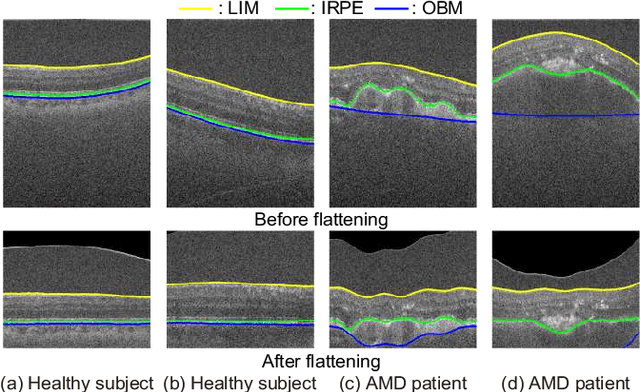
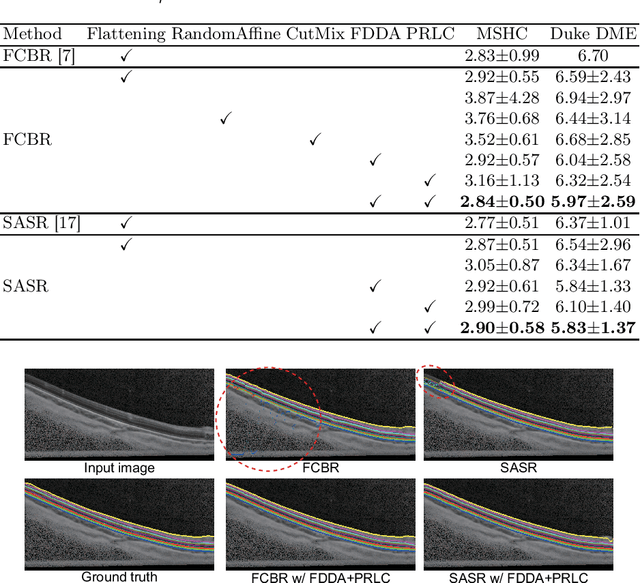
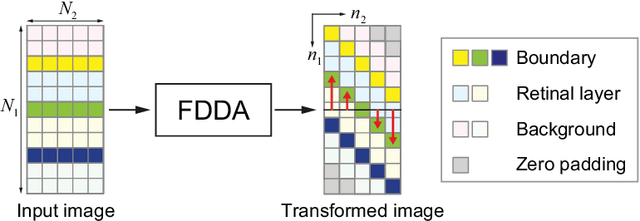

Abstract:Major retinal layer segmentation methods from OCT images assume that the retina is flattened in advance, and thus cannot always deal with retinas that have changes in retinal structure due to ophthalmopathy and/or curvature due to myopia. To eliminate the use of flattening in retinal layer segmentation for practicality of such methods, we propose novel data augmentation methods for OCT images. Formula-driven data augmentation (FDDA) emulates a variety of retinal structures by vertically shifting each column of the OCT images according to a given mathematical formula. We also propose partial retinal layer copying (PRLC) that copies a part of the retinal layers and pastes it into a region outside the retinal layers. Through experiments using the OCT MS and Healthy Control dataset and the Duke Cyst DME dataset, we demonstrate that the use of FDDA and PRLC makes it possible to detect the boundaries of retinal layers without flattening even retinal layer segmentation methods that assume flattening of the retina.
Multibiometrics Using a Single Face Image
Sep 30, 2024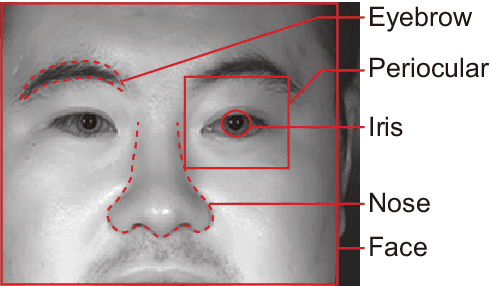
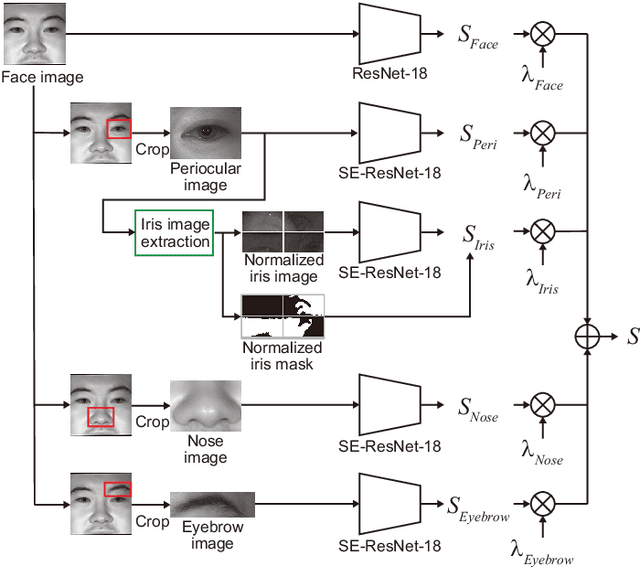
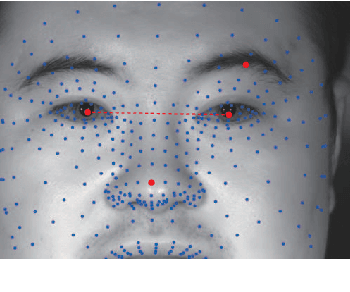
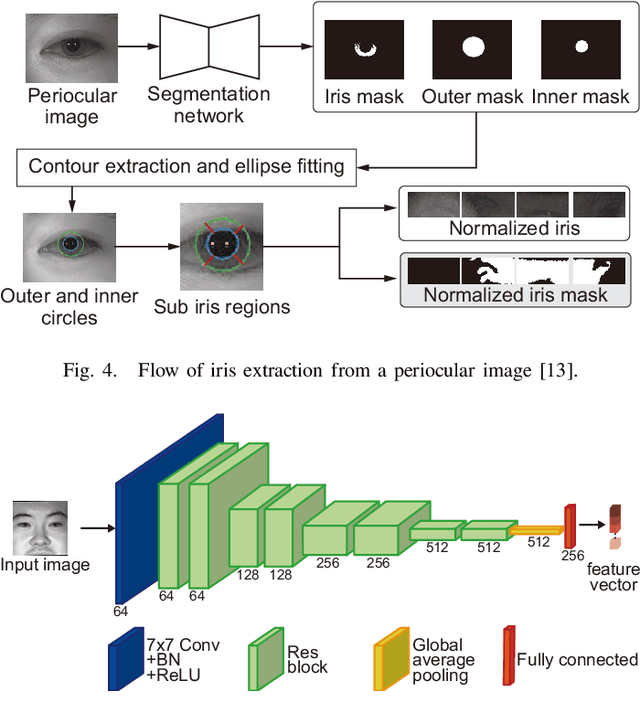
Abstract:Multibiometrics, which uses multiple biometric traits to improve recognition performance instead of using only one biometric trait to authenticate individuals, has been investigated. Previous studies have combined individually acquired biometric traits or have not fully considered the convenience of the system.Focusing on a single face image, we propose a novel multibiometric method that combines five biometric traits, i.e., face, iris, periocular, nose, eyebrow, that can be extracted from a single face image. The proposed method does not sacrifice the convenience of biometrics since only a single face image is used as input.Through a variety of experiments using the CASIA Iris Distance database, we demonstrate the effectiveness of the proposed multibiometrics method.
LabellessFace: Fair Metric Learning for Face Recognition without Attribute Labels
Sep 14, 2024
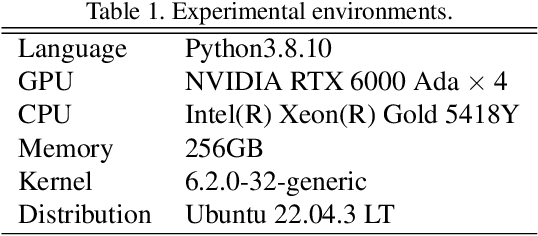


Abstract:Demographic bias is one of the major challenges for face recognition systems. The majority of existing studies on demographic biases are heavily dependent on specific demographic groups or demographic classifier, making it difficult to address performance for unrecognised groups. This paper introduces ``LabellessFace'', a novel framework that improves demographic bias in face recognition without requiring demographic group labeling typically required for fairness considerations. We propose a novel fairness enhancement metric called the class favoritism level, which assesses the extent of favoritism towards specific classes across the dataset. Leveraging this metric, we introduce the fair class margin penalty, an extension of existing margin-based metric learning. This method dynamically adjusts learning parameters based on class favoritism levels, promoting fairness across all attributes. By treating each class as an individual in facial recognition systems, we facilitate learning that minimizes biases in authentication accuracy among individuals. Comprehensive experiments have demonstrated that our proposed method is effective for enhancing fairness while maintaining authentication accuracy.
Assessing bikeability with street view imagery and computer vision
May 13, 2021
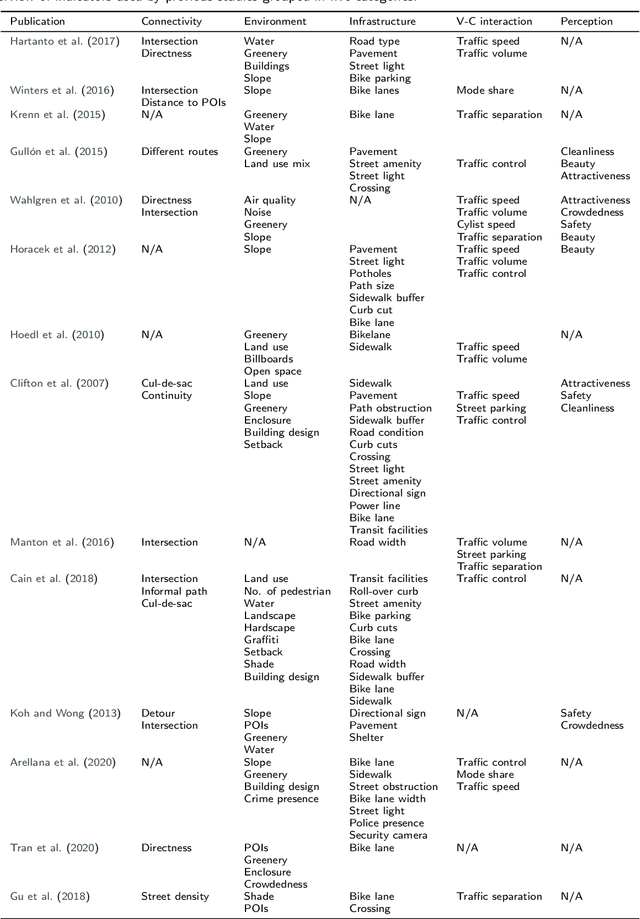
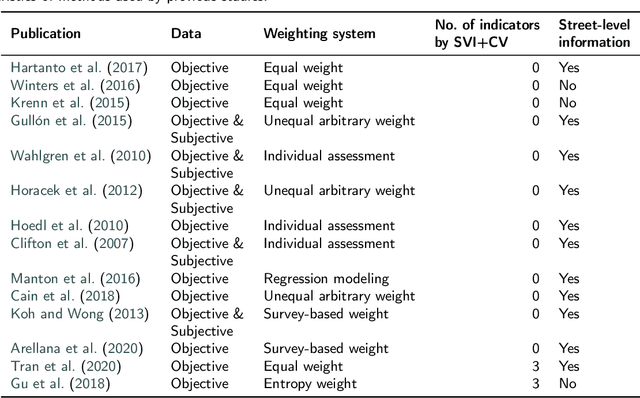
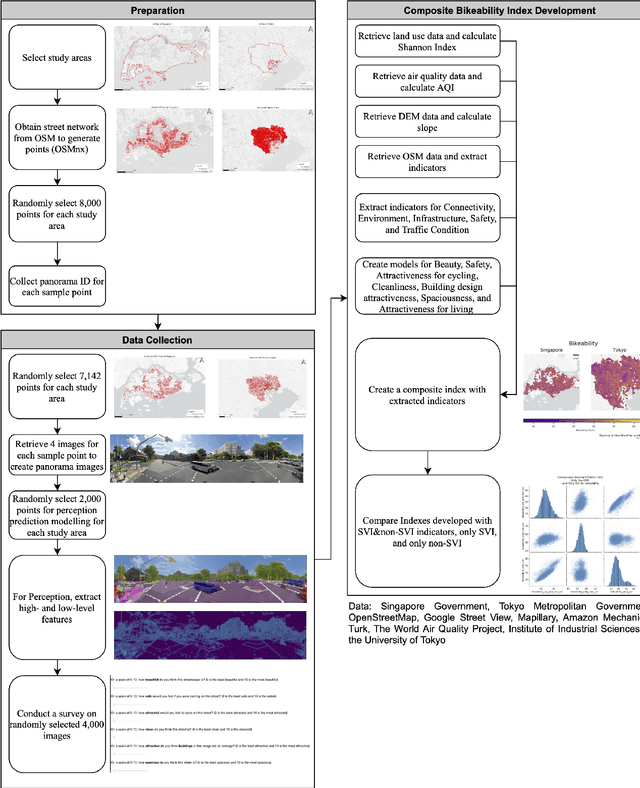
Abstract:Studies evaluating bikeability usually compute spatial indicators shaping cycling conditions and conflate them in a quantitative index. Much research involves site visits or conventional geospatial approaches, and few studies have leveraged street view imagery (SVI) for conducting virtual audits. These have assessed a limited range of aspects, and not all have been automated using computer vision (CV). Furthermore, studies have not yet zeroed in on gauging the usability of these technologies thoroughly. We investigate, with experiments at a fine spatial scale and across multiple geographies (Singapore and Tokyo), whether we can use SVI and CV to assess bikeability comprehensively. Extending related work, we develop an exhaustive index of bikeability composed of 34 indicators. The results suggest that SVI and CV are adequate to evaluate bikeability in cities comprehensively. As they outperformed non-SVI counterparts by a wide margin, SVI indicators are also found to be superior in assessing urban bikeability, and potentially can be used independently, replacing traditional techniques. However, the paper exposes some limitations, suggesting that the best way forward is combining both SVI and non-SVI approaches. The new bikeability index presents a contribution in transportation and urban analytics, and it is scalable to assess cycling appeal widely.
Fingerprint Feature Extraction by Combining Texture, Minutiae, and Frequency Spectrum Using Multi-Task CNN
Aug 27, 2020



Abstract:Although most fingerprint matching methods utilize minutia points and/or texture of fingerprint images as fingerprint features, the frequency spectrum is also a useful feature since a fingerprint is composed of ridge patterns with its inherent frequency band. We propose a novel CNN-based method for extracting fingerprint features from texture, minutiae, and frequency spectrum. In order to extract effective texture features from local regions around the minutiae, the minutia attention module is introduced to the proposed method. We also propose new data augmentation methods, which takes into account the characteristics of fingerprint images to increase the number of images during training since we use only a public dataset in training, which includes a few fingerprint classes. Through a set of experiments using FVC2004 DB1 and DB2, we demonstrated that the proposed method exhibits the efficient performance on fingerprint verification compared with a commercial fingerprint matching software and the conventional method.
Silhouette-Net: 3D Hand Pose Estimation from Silhouettes
Dec 28, 2019


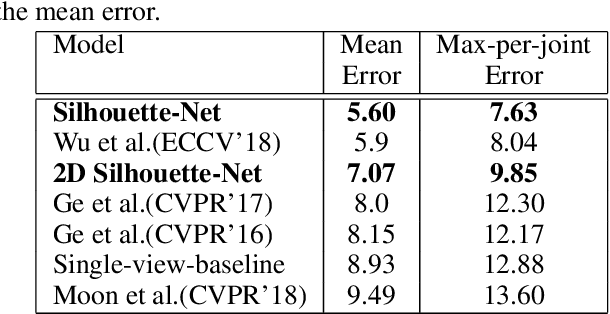
Abstract:3D hand pose estimation has received a lot of attention for its wide range of applications and has made great progress owing to the development of deep learning. Existing approaches mainly consider different input modalities and settings, such as monocular RGB, multi-view RGB, depth, or point cloud, to provide sufficient cues for resolving variations caused by self occlusion and viewpoint change. In contrast, this work aims to address the less-explored idea of using minimal information to estimate 3D hand poses. We present a new architecture that automatically learns a guidance from implicit depth perception and solves the ambiguity of hand pose through end-to-end training. The experimental results show that 3D hand poses can be accurately estimated from solely {\em hand silhouettes} without using depth maps. Extensive evaluations on the {\em 2017 Hands In the Million Challenge} (HIM2017) benchmark dataset further demonstrate that our method achieves comparable or even better performance than recent depth-based approaches and serves as the state-of-the-art of its own kind on estimating 3D hand poses from silhouettes.
 Add to Chrome
Add to Chrome Add to Firefox
Add to Firefox Add to Edge
Add to Edge